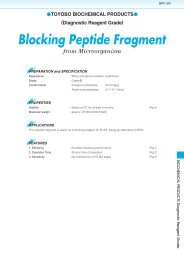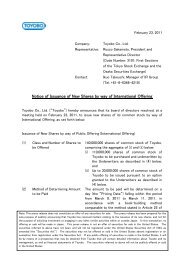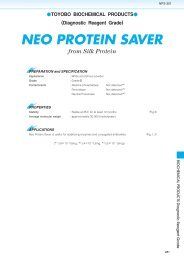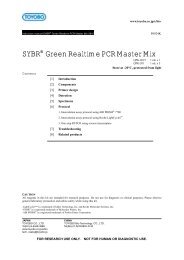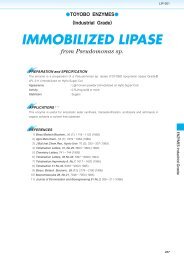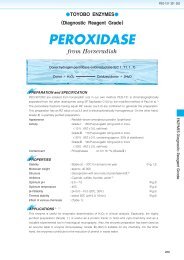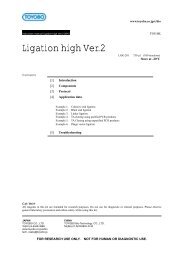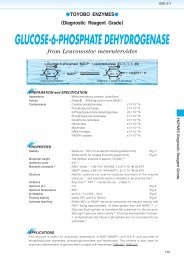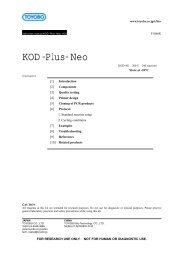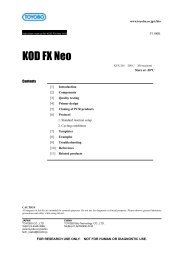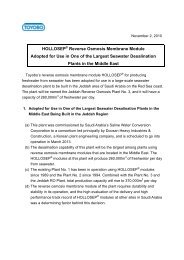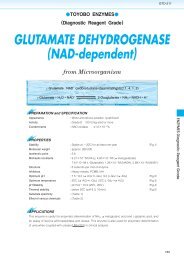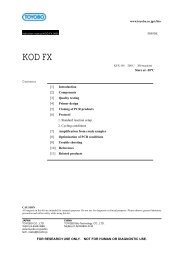HEXOKINASE - Toyobo
HEXOKINASE - Toyobo
HEXOKINASE - Toyobo
Create successful ePaper yourself
Turn your PDF publications into a flip-book with our unique Google optimized e-Paper software.
HXK-301<br />
TOYOBO ENZYMES<br />
(Diagnostic Reagent Grade)<br />
<strong>HEXOKINASE</strong><br />
from Saccharomyces sp.<br />
ATP:D-Hexose 6-phosphotransferase (EC 2. 7. 1. 1)<br />
D-HexoseATP <br />
Mg <br />
D-Hexose-6-phosphateADP<br />
PREPARATION and SPECIFICATION<br />
Appearance<br />
: White amorphous powder, lyophilized<br />
Activity<br />
: Grade150U/mg-solid or more<br />
Contaminants : Phosphoglucose isomerase ≤1.010 1 %<br />
6-Phosphogluconate dehydrogenase ≤1.010 2 %<br />
Glucose-6-phosphate dehydrogenase ≤1.010 2 %<br />
Myokinase ≤1.010 2 %<br />
Glutathione reductase ≤5.010 1 %<br />
PROPERTIES<br />
Stability : Store at 20 Fig.1<br />
(A decrease in activity of ca. 10% may occur within 6 months.)<br />
Molecular weight<br />
: approx. 100,000 1<br />
Michaelis constants<br />
: (Table.1) 2<br />
Structure<br />
: 2 subunits per mol of enzyme 3<br />
Inhibitors<br />
: p-Chloromercuribenzoate, Hg , Ag , sorbose-1-phosphate,<br />
polyphosphates, 6-deoxy-6-fluoroglucose, 2-C-hydoxymethylglucose,<br />
xylose and lyxose. 4,5<br />
Activators<br />
: Mg , catecholamine and its analog 6<br />
Optimum pH : 7.5 Fig.2<br />
Optimum temperature : 40 Fig.3<br />
pH Stability : pH 5.57.5 (20, 17hr) Fig.4<br />
Thermal stability : below 30 (pH 8.0, 30min) Fig.5<br />
Substrate specificity : (Table 1)<br />
APPLICATIONS<br />
This enzyme is useful for enzymatic determination of glucose and adenosine-5'-triphosphate (ATP)<br />
when coupled with glucose-6-phosphate dehydrogenase (=G-6-PDH, G6D-311, G6D-321).
HXK-301<br />
ASSAY<br />
Principle:<br />
hexokinase<br />
D-GlucoseATP<br />
Glucose-6-phosphateNAD <br />
D-Glucose-6-phosphateADP<br />
G-6-PDH<br />
Glucono--lactone-6-phosphateNADHH <br />
The appearance of NADH is measured at 340nm by spectrophotometry.<br />
Unit definition:<br />
One unit causes the formation of one micromole of NADH per minute under the conditions described below.<br />
Method:<br />
Reagents<br />
A. Tris-HCl buffer, pH 8.0<br />
B. Glucose solution<br />
C. ATP solution<br />
D. NAD solution<br />
E. G-6-PDH solution<br />
F. Enzyme diluent<br />
50mM, containing 13.3mM MgCl 2<br />
0.67M in Tris-HCI buffer solution (A) (Should be prepared fresh)<br />
16.5mM in Tris-HCl buffer solution (A) (Should be prepared fresh)<br />
6.8mM in Tris-HCl buffer solution (A) (Should be prepared fresh)<br />
300U/ml (Dilute with Tris-HCl buffer solution (A) and store on ice)<br />
Tris-HCl buffer solution (A) contg. 0.1% of bovine serum albumin<br />
Procedure<br />
1. Prepare the following reagent mixture in a cuvette (d1.0cm)<br />
Concentration in assay mixture<br />
and equilibrate at 30 for about 5 minutes.<br />
Tris-HCl buffer<br />
50 mM<br />
2.3 ml Tris-HCl buffer solution, pH 8.0 (A) Glucose<br />
0.11 M<br />
ATP<br />
0.55 mM<br />
0.50ml Glucose solution (B)<br />
NAD <br />
0.23 mM<br />
0.10ml ATP solution (C)<br />
MgCl 2<br />
13 mM<br />
0.10ml NAD solution (D) BSA<br />
3.3g/ml<br />
0.01ml G-6-PDH solution (E) G-6-PDH<br />
ca.1.0 U/ml<br />
2. Add 0.1ml of the enzyme solutionand mix by gentle inversion.<br />
3. Record the increase in optical density at 340nm against water for 2 to 3 minutes in a spectrophotometer<br />
thermostated at 30 and calculate theOD per minute from the initial linear portion of the curve (OD<br />
test).<br />
At the same time, measure the blank rate (OD blank) by using the same method as the test except that<br />
the enzyme diluent (F) is added instead of the enzyme solution.<br />
<br />
Dissolve the enzyme preparation in ice-cold enzyme diluent (F), dilute to 0.10.2U/ml with the same buffer<br />
and store on ice.<br />
Calculation<br />
Activity can be calculated by using the following formula<br />
OD/min (OD testOD blank)Vtdf<br />
Volume activity (U/ml) <br />
6.221.0Vs<br />
Weight activity (U/mg)(U/ml)1/C<br />
Vt Total volume (3.11ml)<br />
Vs Sample volume (0.1ml)<br />
6.22 Millimolar extinction coefficient of NADH (F/micromole)<br />
1.0 Light path length (cm)<br />
df Dilution factor<br />
C Enzyme concentration in dissolution (c mg/ml)<br />
OD/min5.0df<br />
REFERENCES<br />
1) I.T.Schulze et al.; J.Biol.Chem., 244, 2306 (1969).<br />
2) E.M.Bessell et al.; Bilchem.J., 128, 199 (1972).<br />
3) J.J.Schmidt et al.; Arch.Biochem.Blophys., 158, 458 (1973).<br />
4) M.R.McDonals; Methods in Engymology, vol.1, p.269 Academic press, New York (1955).<br />
5) A.Sole et al.; Biochem.Blophys.Acta, 30, 92 (1958).<br />
6) W.H.Harrison and R.M.Gray; Arch.Biochem.Blophys., 151, 357 (1972).
HXK-301<br />
Table 1. Substrate Specificity of Hexokinase<br />
Substrate Km Value (M) Residual activity<br />
Glucose 1.010 -4 100<br />
Fructose 7.010 -4 180<br />
5-Keto-D-fructose 6.010 -4 150<br />
Mannose 5.010 -5 80<br />
2-Deoxyglucose 3.010 -4 100<br />
Glucosamine (at pH7.5) 1.510 -3 70<br />
N-Acetylglucosamine 1.010 -3 <br />
Glucosone 2.010 -5 0.2<br />
Galactose 5.010 -2<br />
0.002<br />
6-Deoxy-6-fluoroglucose 5.010 -3 <br />
ATP 1.010 -4<br />
lTP 3.710 -3<br />
Mg ++ 2.610 -3<br />
100<br />
100<br />
100<br />
Residual Activity,%<br />
50<br />
-20<br />
5<br />
Relative Activity<br />
50<br />
Residual Activity,%<br />
50<br />
0 1 2 3 4<br />
5<br />
0 6 7 8 9<br />
10<br />
0 5 6 7 8<br />
9<br />
Period (months)<br />
pH<br />
pH<br />
Fig.1. Stability (Powder form)<br />
kept under dry conditions<br />
Fig.2. pH-Activity<br />
30 in the following buffer;pH5.57.5,<br />
14mM veronal-CH3COONa-HCI;<br />
pH7.59.5,50mM NH4OH-NH4Cl<br />
Fig.4. pH-stability<br />
20, 17hr-treatment with<br />
the following buffer solution;<br />
pH5.08.0, 30mM veronal-<br />
CH3COONa-HCI;pH7.59.0,<br />
0.1M Tris-HCI<br />
100<br />
100<br />
Relative Activity<br />
50<br />
Residual Activity,%<br />
50<br />
0 20 30 40 50<br />
60<br />
0 20 30 40 50<br />
60<br />
Temperature, <br />
Temperature, <br />
Fig.3. Temperature activity<br />
in 50mM Tris-HCI buffer,<br />
pH8.0<br />
Fig.5. Thermal stability<br />
30min-treatment with<br />
50mM Tris-HCI buffer,pH8.0<br />
enzyme concn.:80U/ml
HXK-301<br />
<br />
<br />
hexokinase<br />
<br />
<br />
G-6-PDH<br />
<br />
<br />
<br />
<br />
<br />
<br />
<br />
2<br />
<br />
<br />
<br />
<br />
P<br />
<br />
<br />
<br />
P<br />
<br />
<br />
<br />
<br />
P <br />
P <br />
P <br />
P <br />
P <br />
P<br />
<br />
<br />
<br />
<br />
P<br />
<br />
<br />
<br />
P<br />
P<br />
P <br />
<br />
P <br />
<br />
<br />
<br />
P



